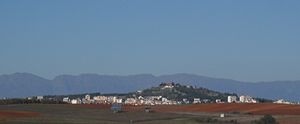
Markos Vafeiadis was a leading figure of the Communist Party of Greece (KKE) during the Greek Resistance and the Greek Civil War.
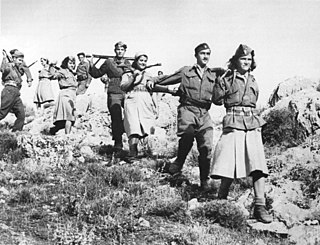
The Greek People's Liberation Army was the military arm of the left-wing National Liberation Front (EAM) during the period of the Greek resistance until February 1945, when, following the Dekemvriana clashes and the Varkiza Agreement, it was disarmed and disbanded. ELAS was the largest and most significant of the military organizations of the Greek resistance.
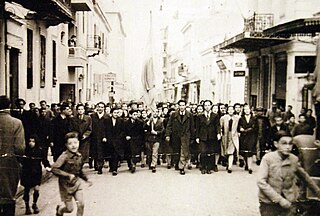
The Greek resistance, involved armed and unarmed groups from across the political spectrum that resisted the Axis occupation of Greece in the period 1941–1944, during World War II. The largest group was the Communist-dominated EAM-ELAS. The Greek Resistance is considered one of the strongest resistance movements in Nazi-occupied Europe, with partisans, men and women known as andartes and andartisses, controlling much of the countryside prior to the German withdrawal from Greece in late 1944.
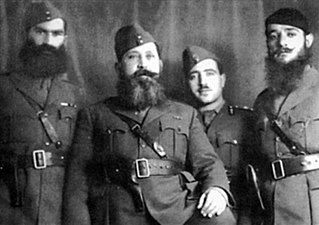
The National Republican Greek League was a major anti-Nazi resistance group formed during the Axis occupation of Greece during World War II.
National and Social Liberation was a Greek Resistance movement during the Axis occupation of Greece. It was founded in autumn 1942 by Colonel Dimitrios Psarros and politician Georgios Kartalis.
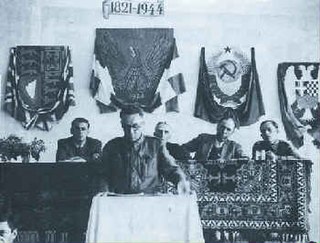
Evripidis Bakirtzis, born in Serres, Ottoman Empire, was a Hellenic Army officer and politician. Dismissed from the army twice due to his participation in pro-republican coup attempts and sentenced to death, later during the Axis Occupation of Greece, in World War II he co-founded the National and Social Liberation (EKKA) resistance group along with Dimitrios Psarros and was the military head of the organization. He later joined and was a prominent member of the National Liberation Front (EAM) and its military wing the Greek People's Liberation Army (ELAS). He served as head of the Political Committee of National Liberation (PEEA), a government of Greek Resistance-held territories also called the "Mountain Government", from 10 March to 18 April 1944. He was nicknamed "the Red Colonel", from his pen name in the newspaper of the Communist Party of Greece, the Rizospastis.

The Security Battalions were Greek collaborationist paramilitary groups, formed during the Axis occupation of Greece during World War II in order to support the German occupation troops.

The occupation of Greece by the Axis Powers began in April 1941 after Nazi Germany invaded the Kingdom of Greece to assist its ally, Italy, in their ongoing war that had started in October 1940. Following the conquest of Crete, the entirety of Greece was occupied starting in June 1941. The occupation of the mainland lasted until Germany and its ally Bulgaria withdrew under Allied pressure in early October 1944, with Crete and some other Aegean islands being surrendered to the Allies by German garrisons in May and June 1945, after the end of World War II in Europe.

Andon Kalchev was a Bulgarian army officer, one of the leaders of the Bulgarian-backed Ohrana, a paramilitary formation of Bulgarians in Greek Macedonia during World War II Axis occupation. He was active outside the Bulgarian occupied area of Macedonia, under the tolerance of the Italian and German authorities which used him in their fights with rival Greek EAM-ELAS and Yugoslav Communist resistance groups. Because of his collaborationist activity, he was sentenced to death by Greek military tribunal, and was executed by firing squad on 27 August 1948.
The National Liberation Front, also known as the People's Liberation Front, was a communist political and military organization created by the Slavic Macedonian minority in Greece. The organization operated from 1945–1949, most prominently in the Greek Civil War. As far as its ruling cadres were concerned its participation in the Greek Civil War was nationalist rather than communist, with the goal of secession from Greece.

Ohrana were armed collaborationist detachments organized by the former Internal Macedonian Revolutionary Organization (IMRO) structures, composed of Bulgarians in Nazi-occupied Greek Macedonia during World War II and led by officers of the Bulgarian Army. Bulgaria was interested in acquiring Thessalonica and Western Macedonia, under Italian and German occupation and hoped to sway the allegiance of the 80,000 Slavs who lived there at the time. The appearance of Greek partisans in those areas persuaded the Axis to allow the formation of these collaborationst detachments. However, during late 1944, when the Axis appeared to be losing the war, many Bulgarian Nazi collaborators, Ohrana members and VMRO regiment volunteers fled to the opposite camp by joining the newly founded communist SNOF. The organization managed to recruit initially 1,000 up to 3,000 armed men from the Slavophone community that lived in the western part of Greek Macedonia.
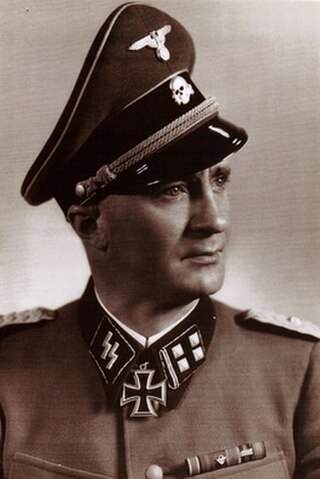
Karl Schümers was a high-ranking commander in the Waffen-SS and Ordnungspolizei (police) of Nazi Germany during World War II. He commanded the SS Polizei Division in July – August 1944 and was directly or indirectly involved in many of the major atrocities committed in Greece during 1944. He was awarded the Knight's Cross of the Iron Cross on 30 September 1942.

The Greek Civil War took place from 1946 to 1949. The conflict, which erupted shortly after the end of World War II, consisted of a communist-dominated uprising against the established government of the Kingdom of Greece. The opposition declared a people's republic, the Provisional Democratic Government of Greece, which was governed by the Communist Party of Greece (KKE) and its military branch, the Democratic Army of Greece (DSE). The rebels were supported by Yugoslavia and the Soviet Union. With the support of the United Kingdom and United States, the Greek government forces ultimately prevailed.
The Panhellenic Liberation Organization, was a Greek resistance organization against the Axis occupation of Greece. It was founded in 1941 by a group of Greek army officers, under the name Defenders of Northern Greece, employing methods of non violent resistance. In 1943, YVE was renamed as the Panhellenic Liberation Organization (PAO), shifting its focus towards armed struggle. In the August of the same year it came into conflict with Greek People's Liberation Army (ELAS), a communist-led resistance organization. PAO was defeated in the ensuing civil war and its remnants turned towards collaboration with the Germans.
Operation Animals was a World War II mission by the British Special Operations Executive (SOE), in cooperation with the Greek Resistance groups ELAS, Zeus, EDES, PAO and the United States Army Air Force. The operation took place between 21 June and 11 July 1943 and included an organized campaign of sabotage in Greece, to deceive the Axis Powers into believing that Greece was the target of an Allied amphibious landing, instead of Sicily. Despite the mission's success, the Greek civilian population suffered from mass reprisals and British intervention into the internal affairs of the Greek resistance exacerbated the tensions between its various components.

The Chortiatis Massacre was a violent reprisal by the Greek collaborationist Security Battalions and German army troops during the Axis Occupation of Greece. On 2 September 1944, a platoon of Greek People's Liberation Army (ELAS) fighters ambushed a government water supply column outside Chortiatis village. Several hours later an Axis penal expedition into the area led to the destruction of the village and the parallel execution of 146 of its citizens, most of whom were women and children.
The Battle of Meligalas took place at Meligalas in Messenia in southwestern Greece, on 13–15 September 1944, between the Greek Resistance forces of the Greek People's Liberation Army (ELAS) and the collaborationist Security Battalions.
Red Terror is a term used by some historians to describe incidents of violence against civilians, by EAM from approximately 1942 or 1943 until the end of the Greek Civil War in 1949. In the countryside, operations were conducted by the ELAS; in cities, by the Organization for the Protection of the People's Struggle (OPLA).
Antonis Fosteridis, also known by the nom de guerre of Çauş Anton, was a Pontus-born Greek nationalist, anticommunist partisan during the Axis occupation of Greece, who served in the Hellenic Army during the Greek Civil War and, during peace time, was elected member of the Hellenic Parliament.
